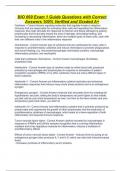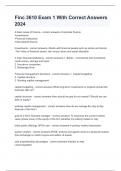BIO 669 Exam 1 Guide Questions with Correct
Answers 100% Verified and Graded A+
Cytokines - Correct Answer signaling molecules that regulate innate or adaptive
immunity that are responsible for activating other cells and regulating the inflammatory
response; they help stimulate the response to infection and tissue damage by guiding
lymphocytes and leukocytes toward the area of damage, stimulating healing, and
increasing or decreasing inflammation; there are multiple types of these cells, each with
their own different roles in the inflammatory response
Chemokines - Correct Answer type of cytokines that are synthesized by many cells in
response to proinflammatory cytokines and induce chemotaxis to promote phagocytosis
and wound healing; e.g. monocyte/macrophage chemotactic proteins, macrophage
inflammatory proteins, and neutrophils
Cells that synthesize chemokines - Correct Answer macrophages, fibroblasts,
endothelial cells
Interleukins - Correct Answer type of cytokine made by white blood cells (produced
primarily by macrophages and lymphocytes) in response to stimulation of pattern
recognition receptors (PRRs) or by other cytokines; there are many different types of
these cytokines
Interleukin-1 - Correct Answer pro-inflammatory cytokine (activates and enhances
inflammatory response) that induces many acute phase proteins and is an endogenous
pyrogen
Endogenous pyrogen - Correct Answer molecule that stimulates fever by resetting the
hypothalamic set point, setting the body's temperature set point higher so that initially
you feel cold as your body temperature as risen, but then as the fever breaks and your
temperature goes back down, you feel hot
Interleukin-10 - Correct Answer anti-inflammatory cytokine that is primarily produced by
lymphocytes and suppresses the growth of other lymphocytes and the production of
proinflammatory cytokines of macrophages, which leads to a down-regulation of both
inflammatory and acquired immune response
Tumor necrosis factor-alpha - Correct Answer cytokine secreted by macrophages in
response to PAMPs and toll-like receptor recognition that is a strong inflammatory
mediator and a key regulatory molecule for inflammation; induces a multitude of
proinflammatory effects
Effects of tumor necrosis factor-alpha - Correct Answer - Induces fever by acting as an
endogenous pyrogen (also produces IL-1 and IL-6, which can also both induce/increase
fever)
- Increases synthesis of inflammatory serum proteins
,- Causes muscle wasting (cachexia) and intravascular thrombosis
- Can cause granuloma formation
TNF-A and biologic agents - Correct Answer tumor necrosis factor alpha is the target of
many biologic agents that try to diminish the immune response when it is
overexpressed/out of proportion; since TNF-A enhances inflammation, drugs that target
TNF-A will ramp DOWN the inflammatory response; e.g. used in treatment of
rheumatoid arthritis, psoriatic arthritis, Crohn's disease (autoimmune conditions where
immune system is too active)
Interferon - Correct Answer cytokine that protects against viral infections and modulate
the inflammatory response
Interferons alpha and beta - Correct Answer Type I interferons that are produced and
released by virally infected host cells in response to viral double-stranded RNA and
other viral PAMPs to protect neighboring healthy cells; don't kill viruses directly
Interferon gamma - Correct Answer Type II interferon that is produced primarily by
lymphocytes to activate macrophages, which results in increased capacity to kill
infectious agents like viruses (and bacteria); key cytokine; increases microbicidal activity
of macrophages
- Plays important role in how well you can clear infection
Mast cells - Correct Answer white blood cells that are the most important cellular
activator of the inflammatory response; cellular bags of granule
- located in the loose connective tissues close to blood vessels (skin, digestive lining,
and respiratory tract)
- their granules contain histamine, cytokines, serotonin, and chemotactic factors that
when released, can lead to a significant inflammatory response
- mediator for pollen, allergic rhinitis, hay fever, etc.
Degranulation of mast cells - Correct Answer most common activation of mast cell
chemical release
- the release of the contents of the mast cell granules (histamine, serotonin, chemotactic
factors, cytokines, etc.) in response to a receptor being engaged that allows for the
stimulation of mast cells
- this receptor is frequently an antibody acting as a receptor (e.g. IgE)
- IgE binds to mast cells, causing them to release and produce a very strong,
immediate, acute immune response (e.g. allergic asthma and other allergic responses)
Basophils - Correct Answer granulocyte found in the BLOOD that most likely act the
same way as mast cells
- least prevalent granulocyte
- primary role unknown
, Synthesis - Correct Answer method of mast cell release in which mast cells produce
and release new mediators in response to a stimulus
Histamine - Correct Answer chemical stored in mast cells and is released during
degranulation that is a vasoactive amine (many vascular effects) and causes:
- temporary, rapid constriction of the large blood vessels
- dilation of the postcapillary venules (resulting in increased blood flow into the
mcirocirculation)
- increased vascular permeability due to the retraction of endothelial cells lining the
capillaries
- allows fluid and proteins to leave the vasculature, leaking out into tissues, which
causes redness, swelling, pain, loss of function, etc. (inflammation!)
Why do antihistamines not reduce all inflammation? - Correct Answer Antihistamines
can reduce some inflammation (the vascular effects caused by histamine), but
histamine is not the only mediator released by mast cells. These mediators also have
inflammatory effects, so they cannot treat all of the effects of inflammation, only the
ones caused by histamine.
Neutrophil chemotactic factor and eosinophilic chemotactic factor of anaphylaxis -
Correct Answer chemotactic factors contained in mast cell granules and released during
degranulation that attract eosinophils and neutrophils, promoting inflammation
Phopholipase A2 - Correct Answer mast cell synthesis can stimulate the production of
this enzyme, which takes the phospholipids from many cell membranes an dconverts
them into arachidonic acid and platelet activating factor
Arachidonic acid - Correct Answer molecule that is broken down/metabolized into
cyclooxygenase and 5-lipoxygenase; these metabolites play key roles in inflammation
Cyclooxygenase - Correct Answer enzyme that produces prostaglandins from
arachidonic acids; targeted by NSAIDs to stop inflammation due to prostaglandins (e.g.
pain, inflammation)
Prostaglandins - Correct Answer fatty acids that are produced from arachidonic acid via
cyclooxygenase that cause increased vascular permeability, neutrophil chemotaxis, and
pain by direct effects on nerves
5-lipooxygenase - Correct Answer enzyme that produces leukotrienes from arachidonic
acid
Leukotrienes - Correct Answer - produced from arachidonic acid from 5-lipooxygenase
- play a role in anaphylaxis
- have vascular effects (increased vascular permeability), like histamine
- cause smooth muscle contraction (like histamine)
- affect the bronchial tree and mediate some of the responses seen in asthma





